 |
||
|
||
| ||
Part 2. Devices from Thermaltake, Titan, and ZalmanPart 1. Devices from Cooler Master, GlacialTech, and ScytheThermaltake Big TyphoonThe next model in our agenda is another Hi-End giant from famous Thermaltake — Big Typhoon. Unlike its predecessors Silent Tower and Tower 112, this new model offers slightly a different ideology and demonstrates a significantly improved design. 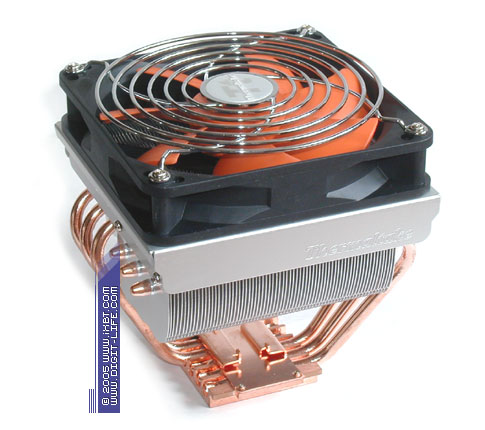 The primary showplace of Big Typhoon is a thermally able 122x122x100 mm heatsink, which working medium is made up of six copper heat pipes (6 mm in diameter) and two sections of 0.2 mm aluminum fins at 1 mm steps (70 pieces in each section), placed horizontally to the copper 50x50x8 mm base. The on-board 120x120x25 mm fan also produces a good impression. It shows decent technical quality along with balanced output (the nominal rotational speed is 1300 rpm). Besides, thanks to its horizontal position, it blows the air through the finning and also provides active convection in the heatsink zone, unloading the hottest areas of the heat pipes. We shouldn't pass over the developed heat exchange surface area, which amounts to 7000 cm2 in Big Typhoon. That's the right spirit, especially considering the compact finning profile (the typical fin size is 55x45 mm).  But with all its novelty and solid design, Big Typhoon didn't manage to get rid of the old technical drawback: heat pipes are soldered to the base of the heatsink, that's OK; but as in case with the old Silent Tower, heat pipes are glued to the finning. Such joints offer much worse thermophysical properties than soldering and do not allow maximum optimization of contact thermal resistance — this fact obviously does not contribute to the positive side of Big Typhoon.  Usability of this updated cooler is also dubious. On one hand, Big Typhoon offers full multiplatform compatibility — its bundle includes a retention module adapted for all current sockets (LGA775, Socket 754/939, Socket 478, and Socket A). But on the other hand, this retention module is almost a complete copy of the retention mechanism in Silent Tower, which used to be mediocre even a year ago. As a result, the installation process remains just as laboursome and unfriendly: installation of this cooler will require long and dreary manipulations with a screwdriver; you will have to pay special attention to even pressure redistribution of the H-shaped bracket, to provide tight installation of the heatsink and avoid skews. So the installation procedure will prove anything but boring! 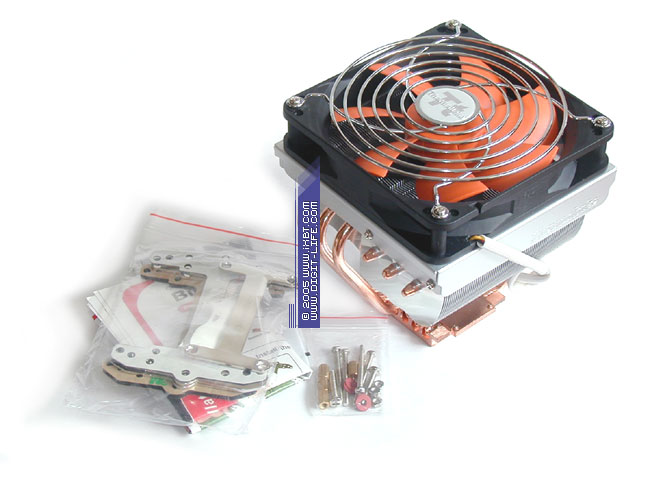 At the same time, despite some technical drawbacks, Big Typhoon fairs very well in our tests. To all appearances, the highly-developed heatsink acts as a magic wand here. This cooler competes well with many strong contenders in thermal efficiency and outperforms such models as Cooler Master Hyper 6+ (1800 rpm) and Zalman CNPS9500 LED (Silent Mode), coming close to the champion results of Scythe Ninja. Its noise characteristics are also quite attractive — Big Typhoon demonstrates a strictly ergonomic noise level and becomes one of the leaders in our today's tests in its efficiency/noise ratio. Thermaltake Sonic TowerAnother model from the Hi-End line of Thermaltake coolers, Sonic Tower, positions as mostly fanless (passive) cooling device, based on a more traditional heat pipe technology. Nevertheless, this model also has fine features and thermal individuality. 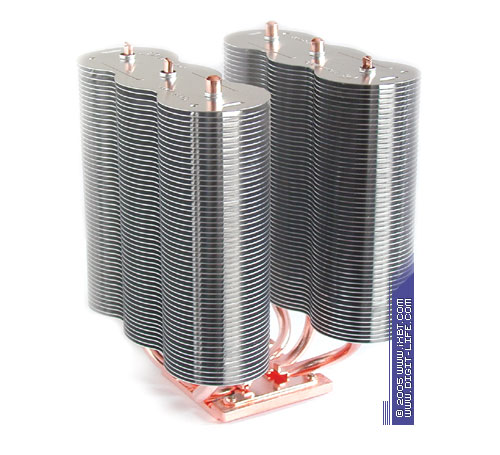 Sonic Tower's heatsink is ideologically similar to its predecessor Silent Tower — it has practically the same copper base (55x55x6 mm) and three vertically oriented heat pipes (6 mm in diameter). But the finning configuration is absolutely different: instead of a single section of square fins, there are two thermally isolated sections of 55 square fins (0.3 mm thick fins at 2 mm steps, typical size - 110x35 mm), each of them attending to its own group of heat pipes. This is quite a reasonable approach — such a technical solution makes a better use of the heat release surface (it's about 8500 cm2 in Sonic Tower — an absolute record for today!) thanks to significantly increased heat exchange ratios of the finning and intensified heat exchange (inter-fin channels are not long, which reduces the resistance and increases the real air flow speed). 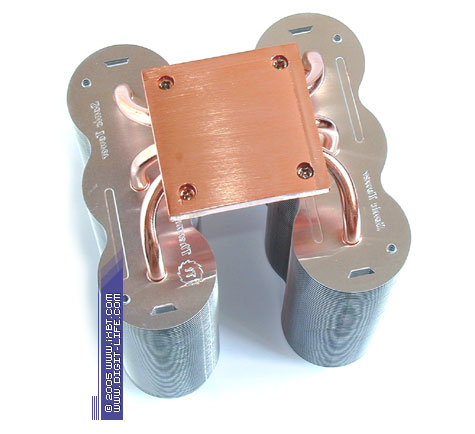 The only disappointment in Sonic Tower is a replay of the sore subject with joints between heat pipes and finning. Their connection is even simpler — fins are threaded on the pipes "dry", without any thermal interface. Though this situation is far from disastrous — contact surface of the fins is pressed into the pipes (that is thermal conductivity is even better than in case of thermal glue) the image of this cooler still suffers. What concerns usability, Sonic Tower is on the contrary in a much better situation: the cooler offers full multiplatform compatibility, and most importantly — the bundled retention module is well thought-out and provides simple and user-friendly installation process, which is not the case with Silent Tower and Big Typhoon. It's especially easy to install Sonic Tower into Socket 754/939 — you just have to tighten two screws (in most cases even without removing a standard retention frame) and that's all! LGA775 offers a similar situation, but it will require more efforts — you will also have to fix two special retention brackets in mounting holes of a motherboard.  Sonic Tower fairs well in thermal efficiency. The best results are demonstrated when it's equipped with two fans (1600 rpm) — in this configuration this model comes close to the results of our champions — Scythe Ninja and Zalman CNPS9500 LED. Equipped with a single fan (on-board model from Big Typhoon, 1300 rpm), the cooler does not work that well and loses some efficiency. But it still rates high in terms of the resulting efficiency/noise ratio. But in the typical passive mode Sonic Tower can be used only with low-power processors, which heat envelope does not exceed 70-80 Watts — the cooler cannot cope with heavier loads and provide acceptable temperature conditions. Titan Vanessa S-typeAnd now let's proceed to a Hi-End pioneer from Titan — Vanessa S-type, which is notable for its attractive exterior and demonstrates good technical innards. 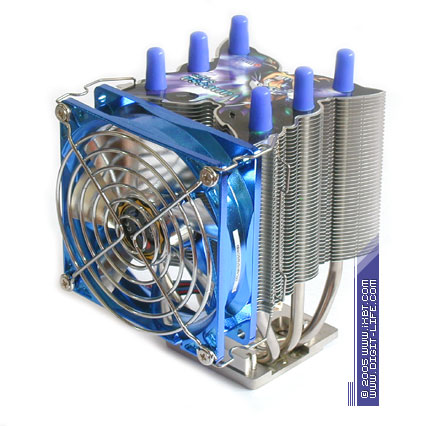 Vanessa S-type's heatsink is of a typical design, ideologically similar to many other products — its working medium (90x86x145 mm) is made up of three copper heat pipes (6 mm in diameter) finished in nickel and a section of aluminum fins (0.2 mm thick, 45 pieces, typical size is 75x70 mm, arranged at 1.5 mm steps) with a copper 55x60x6 mm base (again finished in nickel). Its finning has a special fin shape (by the way, it's well developed — heat exchange surface area amounts to about 4300 cm2) — styled after butterfly wings. But this configuration has no great depth of technical meaning in it. It's just an element of decoration (however, this decoration is quite appropriate, thermal characteristics of the heatsink were not sacrificed). 
 Vanessa S-type also has a typical problem of joints between heat pipes and finning — as in case with Thermaltake Sonic Tower, fins are just pressed on heat pipes without thermal compound, so the thermal contact actually does not reach the required optimum and limits the heat exchange efficiency. But Vanessa S-type demonstrates good usability (unfortunately, it cannot be said about some other typical Hi-End products). The main showplace of the cooler is its thought-out multiplatform retention module, which supports all current sockets. It's no less convenient, even better than retention systems of products, designed for one platform. For example, you won't need a screwdriver to install the cooler on LGA775 — you just have to insert a special retention plate into mounting holes in a motherboard and then to fix the cooler with toolless nuts! You won't have any troubles installing Vanessa S-type on Socket 754/939 systems either, where the heatsink is fixed directly to the mounting frame of the socket.  Other usability elements of the cooler are no less attractive — Vanessa S-type comes shipped with the following accessories: a nice-looking 92x92x25 mm fan (2400 rpm), fan speed controller, retention brackets for the fan speed controller, thermal compound, and a manual. But despite the advanced technical design, Vanessa S-type is an in-and-out performer in our shootout, demonstrating average results. The cooler reaches worthy thermal results only at maximum fan speed (2600 rpm) — in this mode this model outperforms the old Zalman CNPS7700-Cu and comes close to such strong competitors as Thermaltake Silent Tower and Cooler Master Hyper 6+, but its noise exceeds the ergonomic limit and leaves much to be desired. In quiet modes Vanessa S-type looks much worse — noise ergonomics gets better, of course, but the cooler loses much of its efficiency, gets outperformed by many other models, and actually goes down to the budget level. Titan Vanessa L-typeAnother representative of Hi-End Vanessa series from Titan, Vanessa L-type, is essentially different from Vanessa S-type. This product is not quite typical, it possesses bright individuality not only in exterior a-la Madam Butterfly, but also in advanced technical ideology. 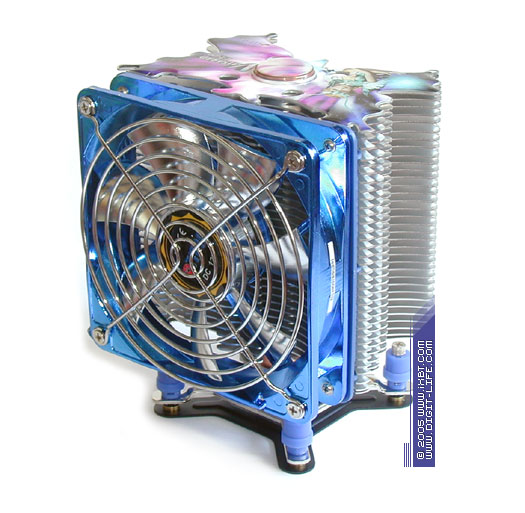 The main feature of Vanessa L-type is its heatsink of a special design, which basis (or rather a backbone) uses a giant heat pipe (25 mm in diameter) instead of the standard set of heat micropipes. That's certainly an original and noteworthy idea! Indeed, such a configuration easily and effectively solves two problems. First of all, one full-size heat pipe can give a start to a dozen of micropipes in energy capacity and heat transfer intensity — possessing advanced characteristics, it deals much more efficiently with its heat transfer responsibilities. And secondly, this pipe directly contacts a processor — that is it makes redundant a special heatsink and thus eliminates side-line losses along the processor-environment heat channel. Well, we can only congratulate Titan's engineers with a new robust model — after a long line of dull products they have finally managed to design something truly interesting and remarkable! 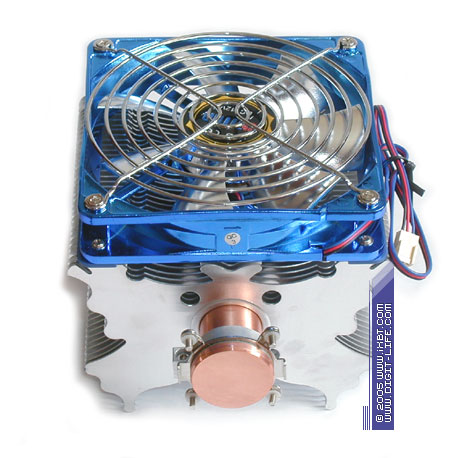 But a closer inspection of Vanessa L-type still reveals some technical drawbacks. The eternal problem of contact quality between a heat pipe and fins — you may have already guessed that they are glued. And though this problem is not so critical in Vanessa L-type (fins are pressed tight; besides, the thermal contact surface area between finning and the heat pipe is twice as large as in Vanessa S-type), soldered joints would have been much better. We also have some gripes with finning configuration — despite its huge dimensions (130x85x115 mm), this section of fins (34 fins, 0.7 mm thick, arranged at 3 mm steps) barely reaches the heat exchange surface area of 4000 cm2. That's not enough. Especially for a heatsink of such design! It's quite obvious that a thinner process technology for making fins (for example, 0.3-0.4 mm) could have accommodated a much larger heat exchange surface area in this volume without damaging pressure and mass parameters of the heatsink and providing redundant minimization of thermal resistance. Well, we have what we have. 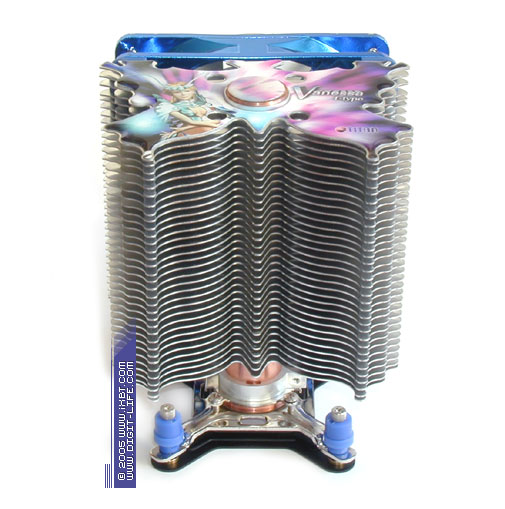 On the contrary, Vanessa L-type has no major drawbacks in usability terms — the cooler is equipped with a multiplatform retention module. Even if less convenient than in Vanessa S-type, it's still user-friendly and spiced up with a good 120x120x25 mm fan (2000 rpm). The bundle also includes: a fan speed controller, retention brackets for the fan speed controller, a screwdriver, thermal compound, and a manual.  Vanessa L-type also has good thermal functionality, achieving remarkable results both at maximum fan speed (2000 rpm) and in quiet mode (1000 rpm). In the latter mode our cooler demonstrates really humane noise characteristics along with a worthy efficiency/noise ratio. Nevertheless, considering all the technical aspects reviewed, it becomes clear that the real potential of Vanessa L-type is unrevealed — being more accurate in details, this cooler might have had good chances for becoming a champion in our today's tests. Zalman CNPS9500 LEDAnd the last cooler to be reviewed in our Hi-End shootout is a new top cooler CNPS9500 LED — a robust model that accumulated the best technological advancements of Korean masters from Zalman.  By the way, the first presentation of CNPS9500 LED, held this year in summer at Computex 2005, created a furore, having become a major event in the sector of cooling systems. Zalman had promised long ago to declassify a new high-tech miracle and it kept the word — it was a real sensation for visitors: the highlight of the program was a giant, nearly half meter, functional cooler dummy that conquered the hearts of computer enthusiasts. Surely there were a lot of jovial and sharp-witted guys — they seriously inquired about when they could expect a proper PC case for this divine creation. After evasive answers from Zalman specialists, they patiently waited for souvenirs — miniature copies arranged around their big brother. :) 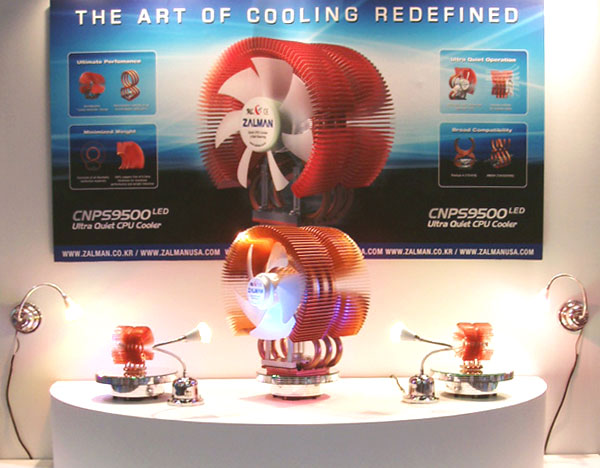 Photo from Zalman's corporate web site Joking aside, even without the typical gloss of Zalman products, the new CNPS9500 LED model is a work of art — we cannot help using superlative degrees when describing its intricate design. Design of the CNPS9500 LED heatsink is truly outstanding! First of all, we should pay attention to the technically superb implementation of heat transfer - a group of three heat pipes (6 mm in diameter), which thermal potential is equivalent to a combination of 6 heat pipes: thanks to the original shape (something like a flattened figure of eight), the heat pipes are arranged to form six areas of thermal contact with the heatsink and three long heat release elements, providing optimized conditions for accepting and transferring heat to the fins. 
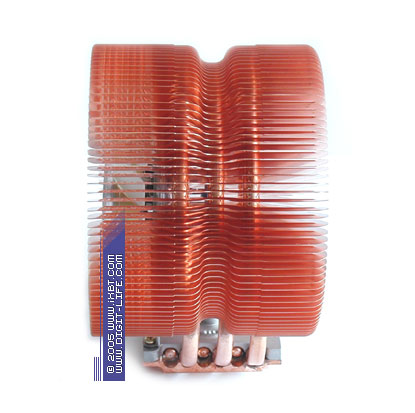 Finning configuration is also remarkable: a section of 90 copper fins (0.2 mm thick) forms a well ventilated radial "fan" (110 mm in diameter) with highly developed heat exchange surface area (about 3700 cm2); moreover, the entire surface works intensively due to the strictly central disposition of the on-board fan (92x92x25 mm) and compact fin size, both in the center (of the thermal contact circle) as well as at the periphery. Well, if it comes to a showdown, we should also add the superb quality of the joints between the heat pipes, fins, and the heatsink - they are soldered to each other to guarantee true minimization of thermal resistance. 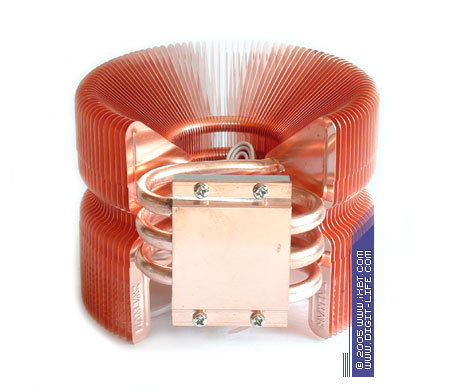 CNPS9500 LED also offers decent usability — the cooler comes shipped with a good retention module, which is compatible with three platforms (LGA775, Socket 754/939, and Socket 478) and provides a user-friendly installation process (especially in Socket 754/939 systems, when the heatsink is fixed with two screws directly to the mounting frame of the socket). The bundle also includes a traditional fan speed controller Fan Mate 2 (it varies the rotational speed from 1400 rpm — Silent Mode, to 2400 rpm — Normal Mode). 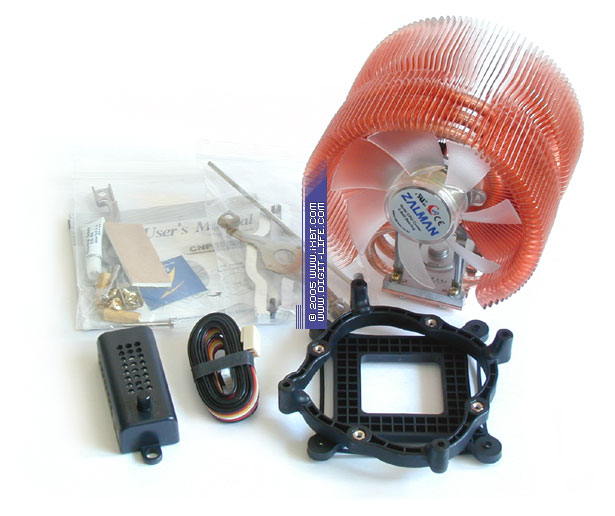 As a result, possessing a number of solid technical benefactors, the CNPS9500 LED appears to be an excellently balanced product. Frankly speaking, it even resembles Mister Incredible from the funniest Pixar cartoon "The Incredibles" — it does not suffer from gigantomania (112x85x125 mm cannot be compared to Thermaltake Big Typhoon), and it's rather light-weight (about 540 g). But it can do a lot thanks to its design! 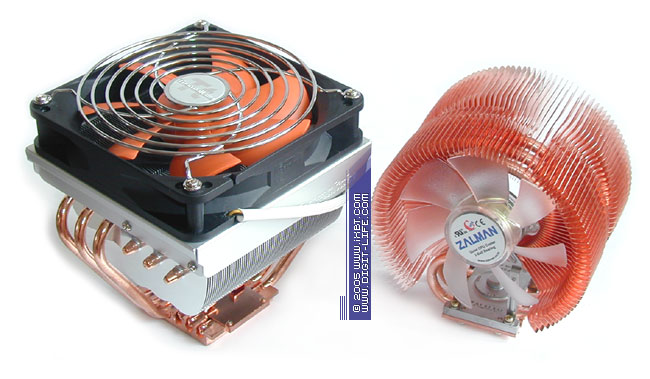 To the credit of Zalman engineers, the new CNPS9500 LED demonstrates truly remarkable results in our today's tests. The cooler achieves the best results in Normal Mode — it's practically beyond competition in this case and is only slightly outperformed by another model — Scythe Ninja with two fans. But this cooler does not generate lots of noise, keeping within the frame of user-friendly noise ergonomics. This cooler does not miss a chance to prove its worth in Silent Mode either — the CNPS9500 LED still demonstrates respectable results. It competes well with many contenders and, as a result, it becomes an absolute champion in the efficiency/noise ratio. Bravo, that's the right spirit! Well, it's time we draw a bottom line under the descriptive part of our shootout. It's time we should get to our test results!
Note: our tests included more coolers with heat pipes, but we decided to skip some of them not to waste time. In particular, they are
Scythe NCU-2005 Scythe NCU-2005 is based on the Heatlane technology, it's a simplified modification of Scythe Shogun
Thermaltake Beetle Thermaltake Beetle is similar to Silent Tower in many respects, featuring simplified finning and garish shroud
Thermaltake Tower 112 Thermaltake Tower 112 is practically a complete copy of Silent Tower in its design, but it has copper fins.
Part 3. Test results, Conclusions
Thermaltake coolers are kindly provided by Thermaltake
Zalman CNPS9500 LED is kindly provided by Zalman Write a comment below. No registration needed!
|
Platform · Video · Multimedia · Mobile · Other || About us & Privacy policy · Twitter · Facebook Copyright © Byrds Research & Publishing, Ltd., 1997–2011. All rights reserved. |